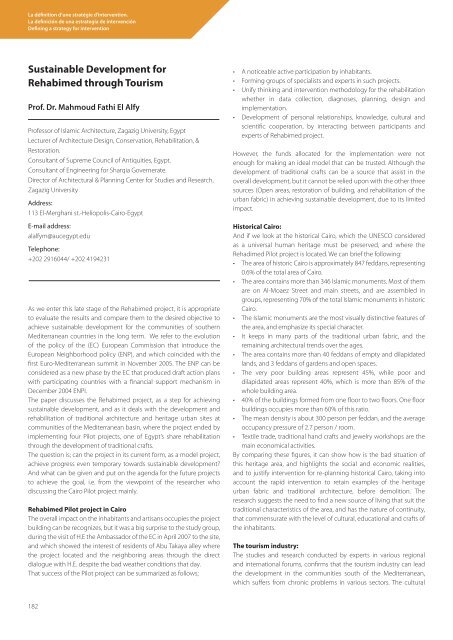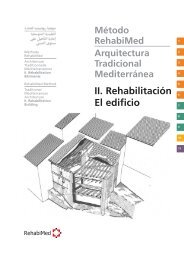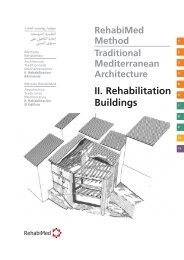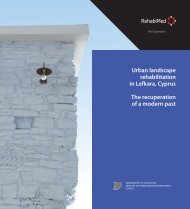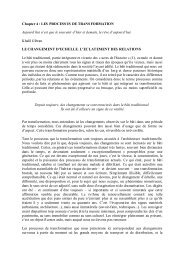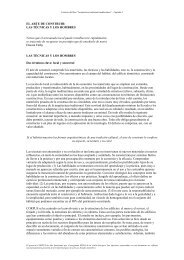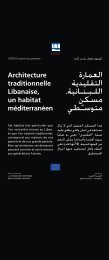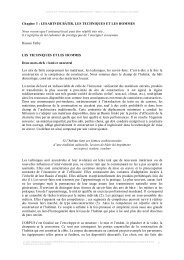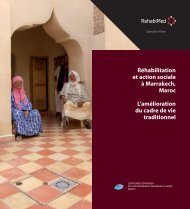La définition d'une stratégie d'intervention. La ... - RehabiMed
La définition d'une stratégie d'intervention. La ... - RehabiMed
La définition d'une stratégie d'intervention. La ... - RehabiMed
You also want an ePaper? Increase the reach of your titles
YUMPU automatically turns print PDFs into web optimized ePapers that Google loves.
<strong>La</strong> <strong>définition</strong> d’une <strong>stratégie</strong> d’intervention.<br />
<strong>La</strong> definición de una estrategia de intervención<br />
Defining a strategy for intervention<br />
Sustainable Development for<br />
Rehabimed through Tourism<br />
Prof. Dr. Mahmoud Fathi El Alfy<br />
Professor of Islamic Architecture, Zagazig University, Egypt<br />
Lecturer of Architecture Design, Conservation, Rehabilitation, &<br />
Restoration.<br />
Consultant of Supreme Council of Antiquities, Egypt.<br />
Consultant of Engineering for Sharqia Governerate.<br />
Director of Architectural & Planning Center for Studies and Research,<br />
Zagazig University<br />
Address:<br />
113 El-Merghani st.-Heliopolis-Cairo-Egypt<br />
E-mail address:<br />
alalfym@aucegypt.edu<br />
Telephone:<br />
+202 2916044/ +202 4194231<br />
As we enter this late stage of the Rehabimed project, it is appropriate<br />
to evaluate the results and compare them to the desired objective to<br />
achieve sustainable development for the communities of southern<br />
Mediterranean countries in the long term. We refer to the evolution<br />
of the policy of the (EC) European Commission that introduce the<br />
European Neighborhood policy (ENP), and which coincided with the<br />
first Euro-Mediterranean summit in November 2005. The ENP can be<br />
considered as a new phase by the EC that produced draft action plans<br />
with participating countries with a financial support mechanism in<br />
December 2004 ENPI.<br />
The paper discusses the Rehabimed project, as a step for achieving<br />
sustainable development, and as it deals with the development and<br />
rehabilitation of traditional architecture and heritage urban sites at<br />
communities of the Mediterranean basin, where the project ended by<br />
implementing four Pilot projects, one of Egypt’s share rehabilitation<br />
through the development of traditional crafts.<br />
The question is; can the project in its current form, as a model project,<br />
achieve progress even temporary towards sustainable development?<br />
And what can be given and put on the agenda for the future projects<br />
to achieve the goal, i.e. from the viewpoint of the researcher who<br />
discussing the Cairo Pilot project mainly.<br />
Rehabimed Pilot project in Cairo<br />
The overall impact on the inhabitants and artisans occupies the project<br />
building can be recognizes, but it was a big surprise to the study group,<br />
during the visit of H.E the Ambassador of the EC in April 2007 to the site,<br />
and which showed the interest of residents of Abu Takaya alley where<br />
the project located and the neighboring areas through the direct<br />
dialogue with H.E. despite the bad weather conditions that day.<br />
That success of the Pilot project can be summarized as follows;<br />
<br />
<br />
<br />
whether in data collection, diagnoses, planning, design and<br />
implementation.<br />
<br />
scientific cooperation, by interacting between participants and<br />
experts of Rehabimed project.<br />
However, the funds allocated for the implementation were not<br />
enough for making an ideal model that can be trusted. Although the<br />
development of traditional crafts can be a source that assist in the<br />
overall development, but it cannot be relied upon with the other three<br />
sources (Open areas, restoration of building, and rehabilitation of the<br />
urban fabric) in achieving sustainable development, due to its limited<br />
impact.<br />
Historical Cairo:<br />
And if we look at the historical Cairo, which the UNESCO considered<br />
as a universal human heritage must be preserved, and where the<br />
Rehadimed Pilot project is located. We can brief the following:<br />
<br />
<br />
<br />
are on Al-Moaez Street and main streets, and are assembled in<br />
<br />
Cairo.<br />
<br />
the area, and emphasize its special character.<br />
<br />
remaining architectural trends over the ages.<br />
<br />
lands, and 3 feddans of gardens and open spaces.<br />
<br />
<br />
whole building area.<br />
<br />
<br />
<br />
occupancy pressure of 2.7 person / room.<br />
<br />
main economical activities.<br />
By comparing these figures, it can show how is the bad situation of<br />
this heritage area, and highlights the social and economic realities,<br />
and to justify intervention for re-planning historical Cairo, taking into<br />
account the rapid intervention to retain examples of the heritage<br />
urban fabric and traditional architecture, before demolition. The<br />
research suggests the need to find a new source of living that suit the<br />
traditional characteristics of the area, and has the nature of continuity,<br />
that commensurate with the level of cultural, educational and crafts of<br />
the inhabitants.<br />
The tourism industry:<br />
The studies and research conducted by experts in various regional<br />
and international forums, confirms that the tourism industry can lead<br />
the development in the communities south of the Mediterranean,<br />
which suffers from chronic problems in various sectors. The cultural<br />
182


